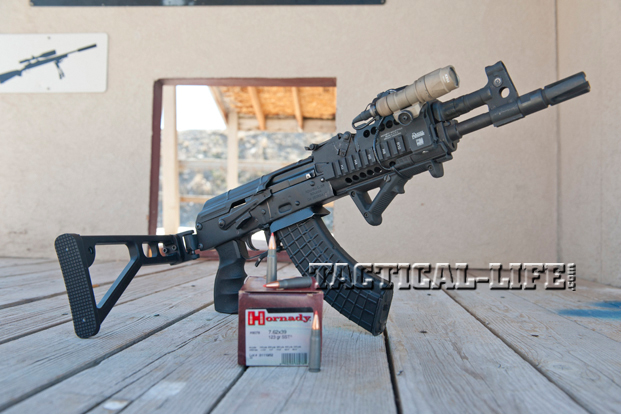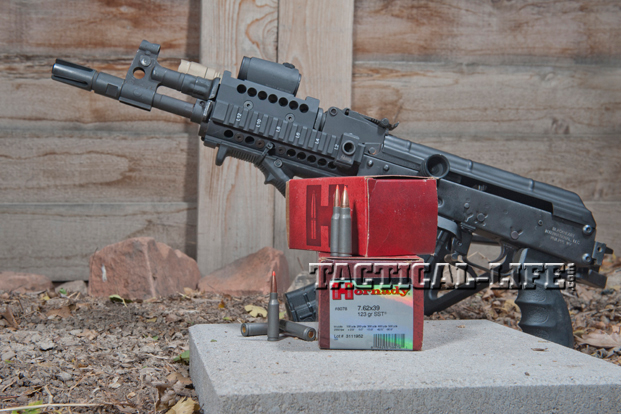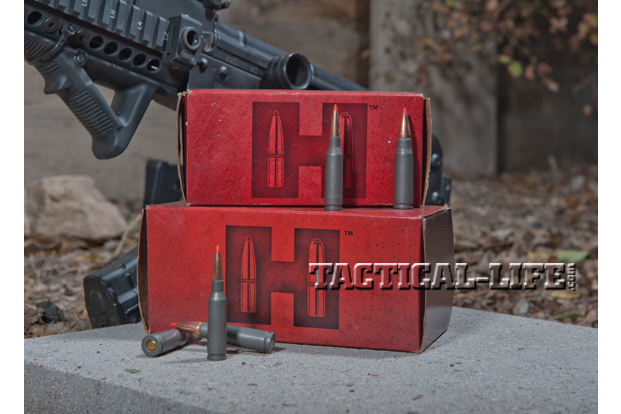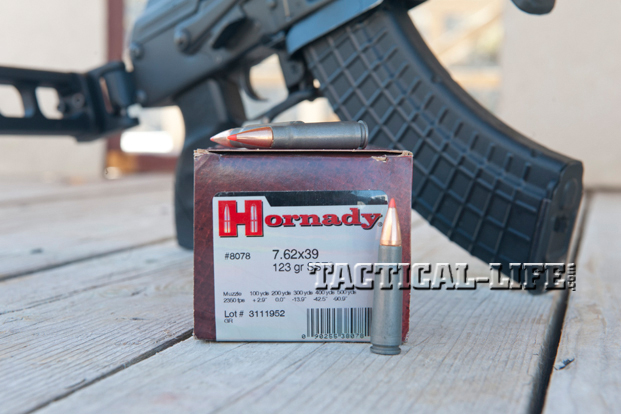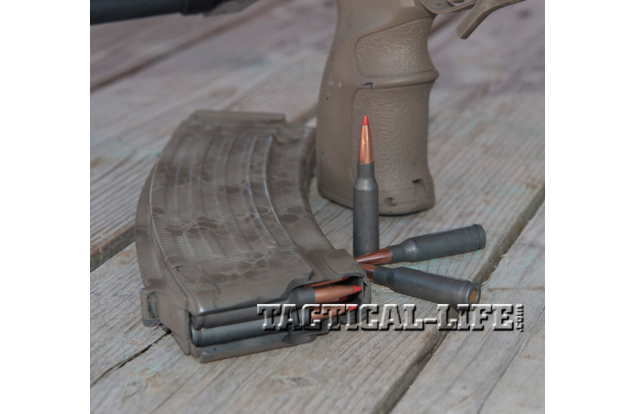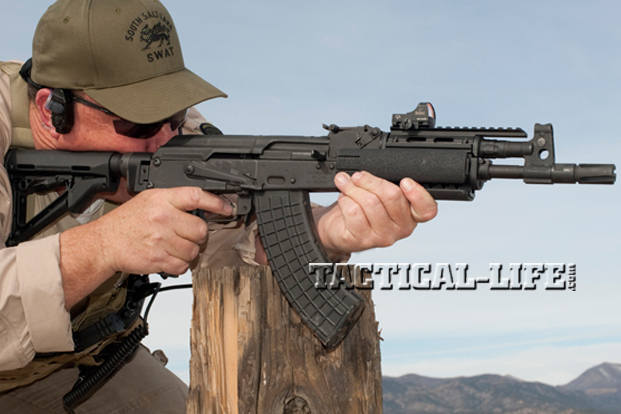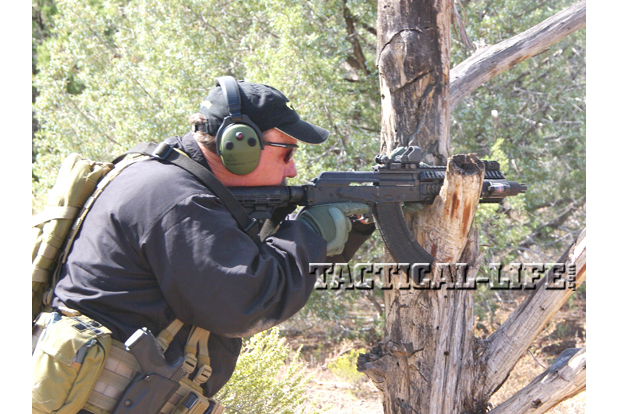Steel-Cased Cartridges
The perpetual debate over steel-cased ammunition is one of the most heated of the firearms world. The differences are clear, the reasons simple, and the value of either is anything but rocket science. There is little doubt that brass is the most ideal material that is currently available for metallic cartridges. It is more malleable and conforms to chambers, which leads to better accuracy. No coating is required to combat rust or ensure a decent seal and proper extraction. Although steel cases can be reloaded, it is a difficult—brass is the ticket for reloading. Brass is less abrasive on chambers and easier on extractors, and for many firearms brass should be your first and possibly only choice. That is not, however, the case for all.
Steel Casing
Steel-cased ammunition is more affordable than brass. For those countries in the former communist “bloc,” steel was really the only choice. It could be mass-produced and yielded adequate combat accuracy when brass was unavailable, and steel remains the primary case-material for military and civilian ammunition manufactured in Russia today.
Most Russian weapons are designed from the start to function with steel-cased loads. Chambers in the 5.45x39mm and 7.62x39mm are simply not as tight as others and are thus able to handle the increased friction from steel and the different coatings on the cartridges. Steel cases require more rearward pressure to reliably extract—fortunately AKs chuck cases with a lot of power——requiring more force and a stronger extractor. This form of extraction is why case-head separation is exacerbated by brass-cased ammunition in similar weapon, something we may see more often with the increased popularity of 5.56mm AKs.
Advertisement — Continue Reading Below
Case-head separation can even occur with the AR platform, a system using a pretty gentle extraction cycle. When subjected to significant increases in rearward force and an ultra strong extractor, the likelihood of separation only increases. My first experience with this occurred using a Micro-Galil: The weapon tried to feed the next round inside the stuck case (minus the case head), resulting in an out-of-battery detonation—very exciting! Attesting to the strength of the Galil, neither it nor I suffered any permanent injury.
I witnessed the same thing occur a year later while I was attending a SWAT school on a Marine base: It happened with an M4 and resulted in a fragmented weapon and serious injury to the shooter. In 15-plus years of shooting rifles, I have witnessed or experienced this a total of five times, but none of the steel cases resulted in out-of-battery detonations. The last detonation occurred a few weeks ago with new 5.56mm ammunition loaded in a brand new AK-47. Again, no injury, just a stuck case for the most part.
Although rare, case-head separation occurs almost without regard to weapon manufacture—it’s simple physics—though it seldom occurs with steel-cased ammunition in AK-based rifles. When it does, it is often due to old ammunition that has corroded over time, one of the reasons why using new steel-cased ammunition is important.
Hornady’s Steel
The least expensive steel-cased ammunition are still Communist bloc military surplus loads, but new manufacture is prevalent and available. Like any ammunition, it is made in various levels of quality with commensurate cost, and these days ammunition costs are high and brass ammunition is higher. For those looking to get affordable ammunition for practice, steel is fast becoming a first choice. Although many experience mixed results using steel-cased loads in an AR, seldom is it problematic in an AK-based system. Steel cases can be coated in lacquer or similar coatings with some of the newest offerings coated in polymer, which seems to do a better job of sealing without increasing the difficulty of extraction. Coupled with noncorrosive powders and decent bullets, polymer-coated steel-cased ammo can yield better accuracy with increased reliability. One of the newcomers to this market is Hornady’s SST, Z-MAX and V-MAX steel-cased loads. Each is loaded with noncorrosive powders and Berdan primers at Hornady’s facility.
The 7.62x39mm is offered with two projectiles: The 123-grain SST is an excellent all-around bullet with good accuracy and rapid expansion, and the 123-grain Z-MAX is for those in need of protection from the local Zombie horde. Just a green-tipped V-MAX for the most part, the Z-MAX offers more rapid expansion with a bit less penetration than the SST.
For the 5.45x39mm Hornady loads the long proven 60-grain V-MAX. This bullet offers a soft jacket and polymer tip for rapid expansion, is flat shooting and has been used with great effect on smaller game in several loadings for years. The V-MAX is likely one of the most accurate varmint bullets available in the .224 caliber and is one of the more accurate 5.45x39mm rounds I have used. All Hornady ammunition is built with great attention to detail and quality control, offering a more affordable yet higher quality steel-cased round that is loaded in the U.S.
Advertisement — Continue Reading Below
Downrange
Over the last two years my time with the Hornady loadings has been significant. Since my introduction to the AK years ago, it has remained one of my favorites as a go-to rifle. Built properly, AKs exhibit more than adequate accuracy with 100 percent reliability under any conditions. But given their import restrictions and overall rise in cost, AK rifles are no longer “cheap” by any means, which makes good ammunition critical—and my experience with the Hornady has been excellent. One of my favorite rifles is an AK-74 put together by friend and expert AK builder Steve Palano. It started life as an Interarms with mostly ergonomic changes, and its overall operating system remains the same today. This rifle was built for and used in a Graham Tactical class a couple years ago, firing over 500 rounds of Hornady in a couple days during some very wet, muddy and dirty conditions. Since then this AK-74 has seen a couple thousand more rounds of Hornady and at least as much from an assortment of other manufacturers. The Hornady is consistently more accurate than the other loads and has never suffered a malfunction. Initial testing of the AK-74 yielded groups at or under 2 inches at 100 yards using a red-dot.
My other dedicated AK is a Draco that was turned into an SBR by Blackheart International. Since the initial test, this SBR has seen nothing but Hornady’s Z-MAX steel-cased rounds. The initial testing yielded 2.4-inch groups at 100 yards with a Burris red-dot. Subsequent groups with a Trijicon T1 and Midwest Industries forend have yielded groups just a tad under 2 inches. This AK-47 has seen several department qualifications as well as a couple thousands rounds with no malfunctions, becoming my primary go-to rifle and loaded with
Hornady 123-grain Z-MAX steel.
Final Thoughts
Although a change in politics may cause some of the hysteria to subside, ammunition prices have not gone down and probably won’t. This means there is a solid place in the firearms world for well-manufactured steel-cased ammunition. Many shooters are using it in their AR rifles with no issues, and those shooting the 5.56mm AKs that are so popular now may find steel-cased ammo perfect, perhaps the future of affordable ammunition.
Although the cobbled together hodge-podge of parts guns are still around, many AKs are now being made with U.S. parts and now with much greater attention to detail. Having U.S.-manufactured ammunition only provides shooters with more choices, which we hope will increase in time. For now, Hornady’s 5.45x39mm and 7.62x39mm steel-cased ammunition is a solid choice, providing accuracy, quality and reliability. Your rifle is only as good as the ammunition it is fed, and Hornady loads are some of the best around.
For more information, visit hornady.com or call 800-338-3220. ★
Advertisement — Continue Reading Below
